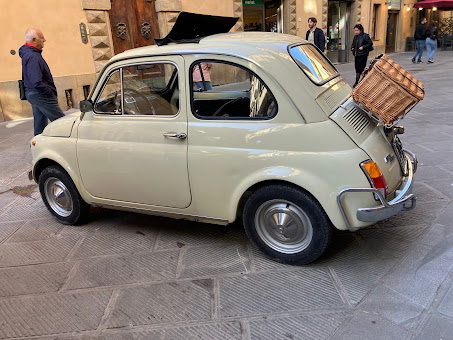This morning, we traveled to the walled hilltop city of Volterra,
famous for alabaster artworks and frescoes. It is one of the best-preserved medieval
cities in Italy. Higher and higher we
climbed as Jackie, our tour director, gave us a succinct summary of Roman
history. When you
travel in Italy, you travel through time as well as distance, and Jackie knew her history well.
Since ancient times, the people of central Italy have mined alabaster from these hills in Tuscany. The ancient Etruscans who built cities on the hilltops prized the stone for its durability and beauty, and we passed several workshops where it was being transformed into beautiful sculpture.
Jackie took us to the summit of the city overlooking the Tuscan countryside, and below us was a well-preserved Roman amphitheater dating to 80 A.D., complete with Roman baths. She said that it had only been discovered 50 years ago when a parking lot was under construction and artifacts began to be uncovered. The area had been covered in trash and dirt all that time.
It was Sunday morning, and the little shops and cafés were just starting to open. I enjoyed a cup of cappuccino (which I have come to appreciate in Italy) at an outdoor table while Martha explored some of the shops. This tiny, classic Fiat was parked in the street - what a gem, though even smaller than our Mini Cooper (I'm not sure I could have gotten behind the wheel.)
Next to the car, a chef was preparing something under a red awning, and spectators began to arrive and watch what I realized was an outdoor cooking demonstration here in a narrow street on a Sunday morning. He rolled out dough and smacked it loudly a few times with his fist - it turned out that he was making bread, and while my Italian is not very good I could almost follow what he was saying. I loved stumbling on these little unexpected surprises on this tour.
We left Volterra for a farmhouse in San Gimignano, an agritourism family-run farm that specialized in the production of saffron, an extremely expensive spice that I don’t believe I have ever used. The reason it is so expensive (and why I have likely never used it) is that the tiny threads are harvested by hand meticulously from the saffron crocus. We learned that it takes 450,000 flowers to produce one kilo of saffron, which is why is is worth 50,000 euros per kilo.
The threads, technically stigmas of the flower, were being carefully pulled from the flowers by some family members as we walked by. One of them had a glass of wine on the table, and it looked like an enjoyable way to spend a sunny afternoon doing such delicate work.
We then made out way to a covered
outdoor dining room where we enjoyed a farm dinner consisting of cheese gnocchi
flavored with saffron, honey, and bread, all produced from products raised on
the farm. A jar of the expensive spice was passed around. What an interesting aroma, sweet and musky, unlike anything I know.
It was a delicious lunch, and at the end of it, the owner/chef came out to greet us. She did not speak English very well, but she introduced us to her granddaughter, who she said in broken English was “her future.”








No comments:
Post a Comment